Learning Through Playing: ESL Task Design for Toddlers at University
VerifiedAdded on 2023/01/04
|20
|4086
|26
Homework Assignment
AI Summary
This assignment focuses on designing original ESL materials for toddlers, emphasizing learning through play. The student outlines six tasks, each aimed at enhancing specific skills like friendship, alphabet recognition, imaginative power, and spelling. The tasks incorporate diverse materials, including videos, presentations, and hands-on activities like using whipped cream for alphabet creation and fairy tale dramatization. The assignment details the aims, materials, procedures, variations, homework assignments, follow-up activities, and expected outcomes for each task, ensuring a well-rounded approach to language acquisition and cognitive development in a multicultural classroom setting. The tasks aim to improve concentration, accuracy, and cognition, integrating the four macro skills: speaking, listening, reading, and writing.
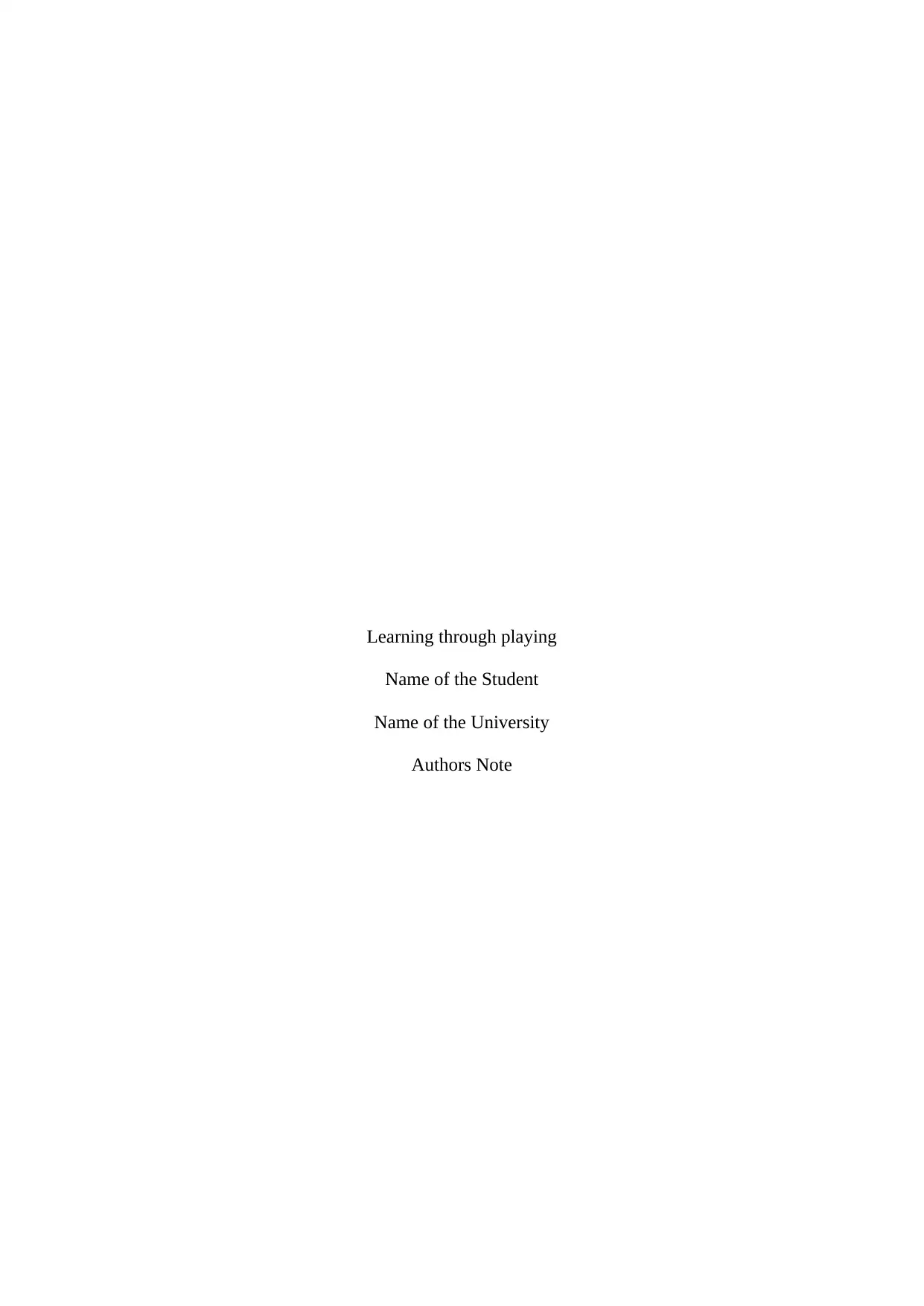
Learning through playing
Name of the Student
Name of the University
Authors Note
Name of the Student
Name of the University
Authors Note
Paraphrase This Document
Need a fresh take? Get an instant paraphrase of this document with our AI Paraphraser
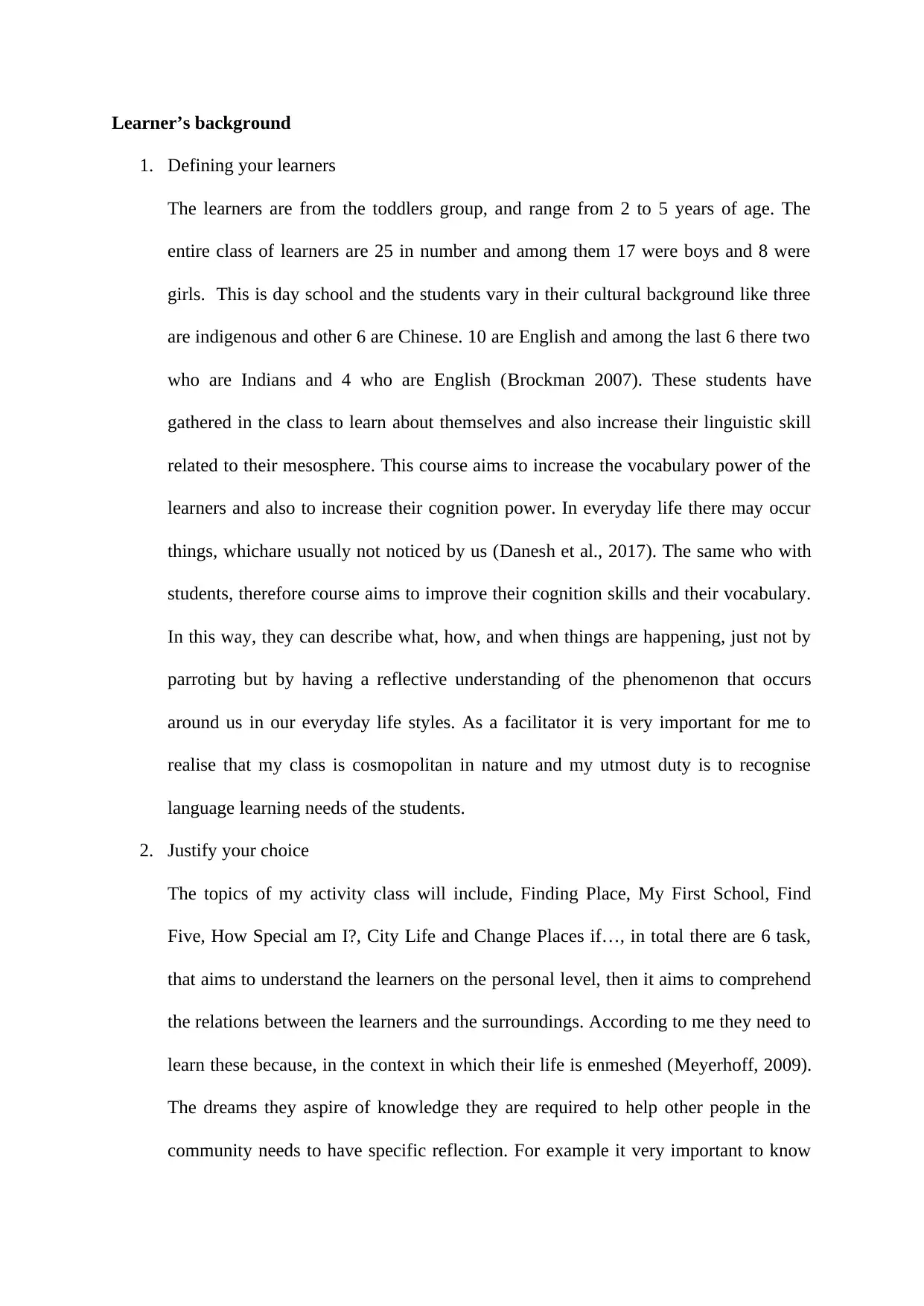
Learner’s background
1. Defining your learners
The learners are from the toddlers group, and range from 2 to 5 years of age. The
entire class of learners are 25 in number and among them 17 were boys and 8 were
girls. This is day school and the students vary in their cultural background like three
are indigenous and other 6 are Chinese. 10 are English and among the last 6 there two
who are Indians and 4 who are English (Brockman 2007). These students have
gathered in the class to learn about themselves and also increase their linguistic skill
related to their mesosphere. This course aims to increase the vocabulary power of the
learners and also to increase their cognition power. In everyday life there may occur
things, whichare usually not noticed by us (Danesh et al., 2017). The same who with
students, therefore course aims to improve their cognition skills and their vocabulary.
In this way, they can describe what, how, and when things are happening, just not by
parroting but by having a reflective understanding of the phenomenon that occurs
around us in our everyday life styles. As a facilitator it is very important for me to
realise that my class is cosmopolitan in nature and my utmost duty is to recognise
language learning needs of the students.
2. Justify your choice
The topics of my activity class will include, Finding Place, My First School, Find
Five, How Special am I?, City Life and Change Places if…, in total there are 6 task,
that aims to understand the learners on the personal level, then it aims to comprehend
the relations between the learners and the surroundings. According to me they need to
learn these because, in the context in which their life is enmeshed (Meyerhoff, 2009).
The dreams they aspire of knowledge they are required to help other people in the
community needs to have specific reflection. For example it very important to know
1. Defining your learners
The learners are from the toddlers group, and range from 2 to 5 years of age. The
entire class of learners are 25 in number and among them 17 were boys and 8 were
girls. This is day school and the students vary in their cultural background like three
are indigenous and other 6 are Chinese. 10 are English and among the last 6 there two
who are Indians and 4 who are English (Brockman 2007). These students have
gathered in the class to learn about themselves and also increase their linguistic skill
related to their mesosphere. This course aims to increase the vocabulary power of the
learners and also to increase their cognition power. In everyday life there may occur
things, whichare usually not noticed by us (Danesh et al., 2017). The same who with
students, therefore course aims to improve their cognition skills and their vocabulary.
In this way, they can describe what, how, and when things are happening, just not by
parroting but by having a reflective understanding of the phenomenon that occurs
around us in our everyday life styles. As a facilitator it is very important for me to
realise that my class is cosmopolitan in nature and my utmost duty is to recognise
language learning needs of the students.
2. Justify your choice
The topics of my activity class will include, Finding Place, My First School, Find
Five, How Special am I?, City Life and Change Places if…, in total there are 6 task,
that aims to understand the learners on the personal level, then it aims to comprehend
the relations between the learners and the surroundings. According to me they need to
learn these because, in the context in which their life is enmeshed (Meyerhoff, 2009).
The dreams they aspire of knowledge they are required to help other people in the
community needs to have specific reflection. For example it very important to know
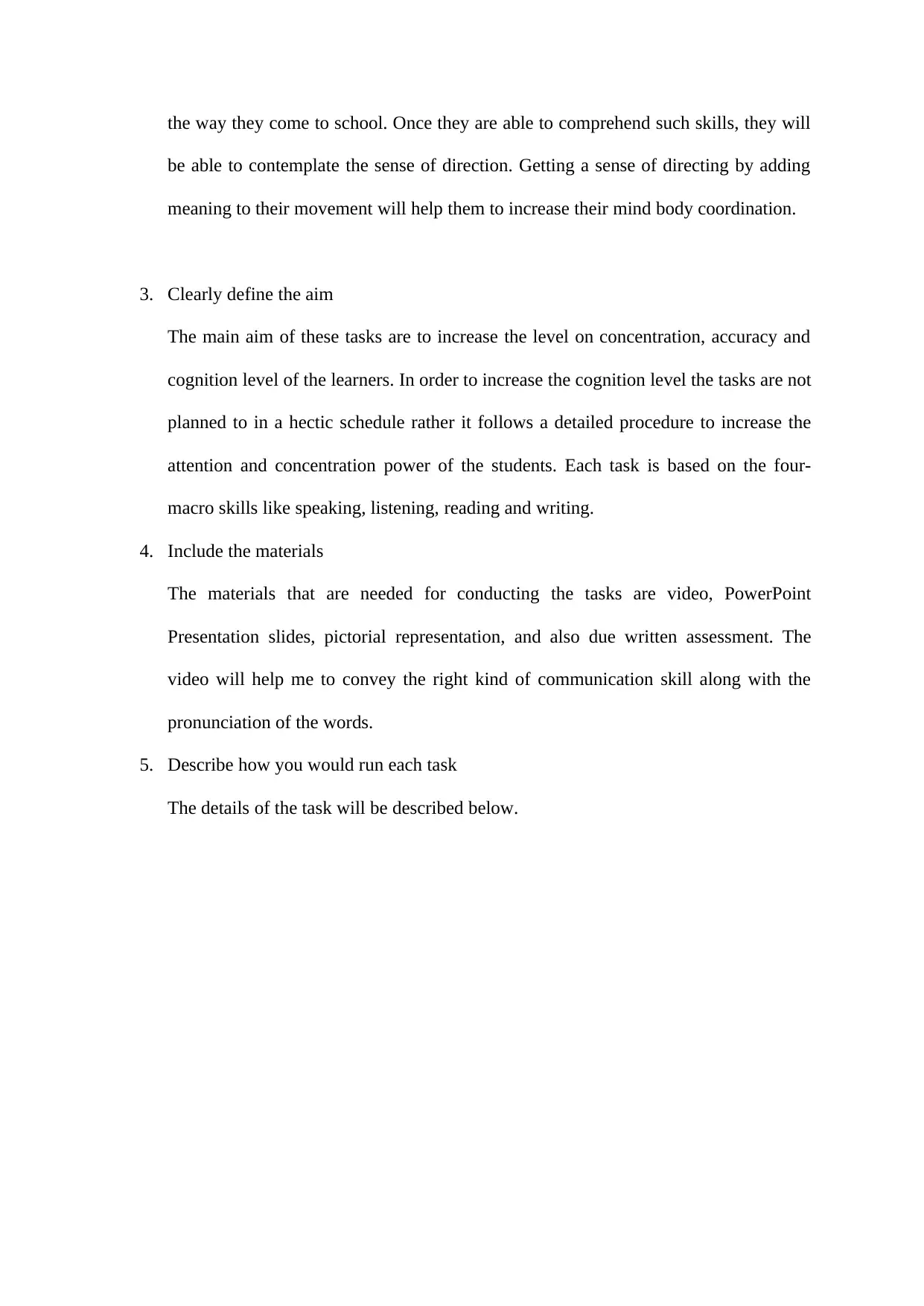
the way they come to school. Once they are able to comprehend such skills, they will
be able to contemplate the sense of direction. Getting a sense of directing by adding
meaning to their movement will help them to increase their mind body coordination.
3. Clearly define the aim
The main aim of these tasks are to increase the level on concentration, accuracy and
cognition level of the learners. In order to increase the cognition level the tasks are not
planned to in a hectic schedule rather it follows a detailed procedure to increase the
attention and concentration power of the students. Each task is based on the four-
macro skills like speaking, listening, reading and writing.
4. Include the materials
The materials that are needed for conducting the tasks are video, PowerPoint
Presentation slides, pictorial representation, and also due written assessment. The
video will help me to convey the right kind of communication skill along with the
pronunciation of the words.
5. Describe how you would run each task
The details of the task will be described below.
be able to contemplate the sense of direction. Getting a sense of directing by adding
meaning to their movement will help them to increase their mind body coordination.
3. Clearly define the aim
The main aim of these tasks are to increase the level on concentration, accuracy and
cognition level of the learners. In order to increase the cognition level the tasks are not
planned to in a hectic schedule rather it follows a detailed procedure to increase the
attention and concentration power of the students. Each task is based on the four-
macro skills like speaking, listening, reading and writing.
4. Include the materials
The materials that are needed for conducting the tasks are video, PowerPoint
Presentation slides, pictorial representation, and also due written assessment. The
video will help me to convey the right kind of communication skill along with the
pronunciation of the words.
5. Describe how you would run each task
The details of the task will be described below.
⊘ This is a preview!⊘
Do you want full access?
Subscribe today to unlock all pages.

Trusted by 1+ million students worldwide
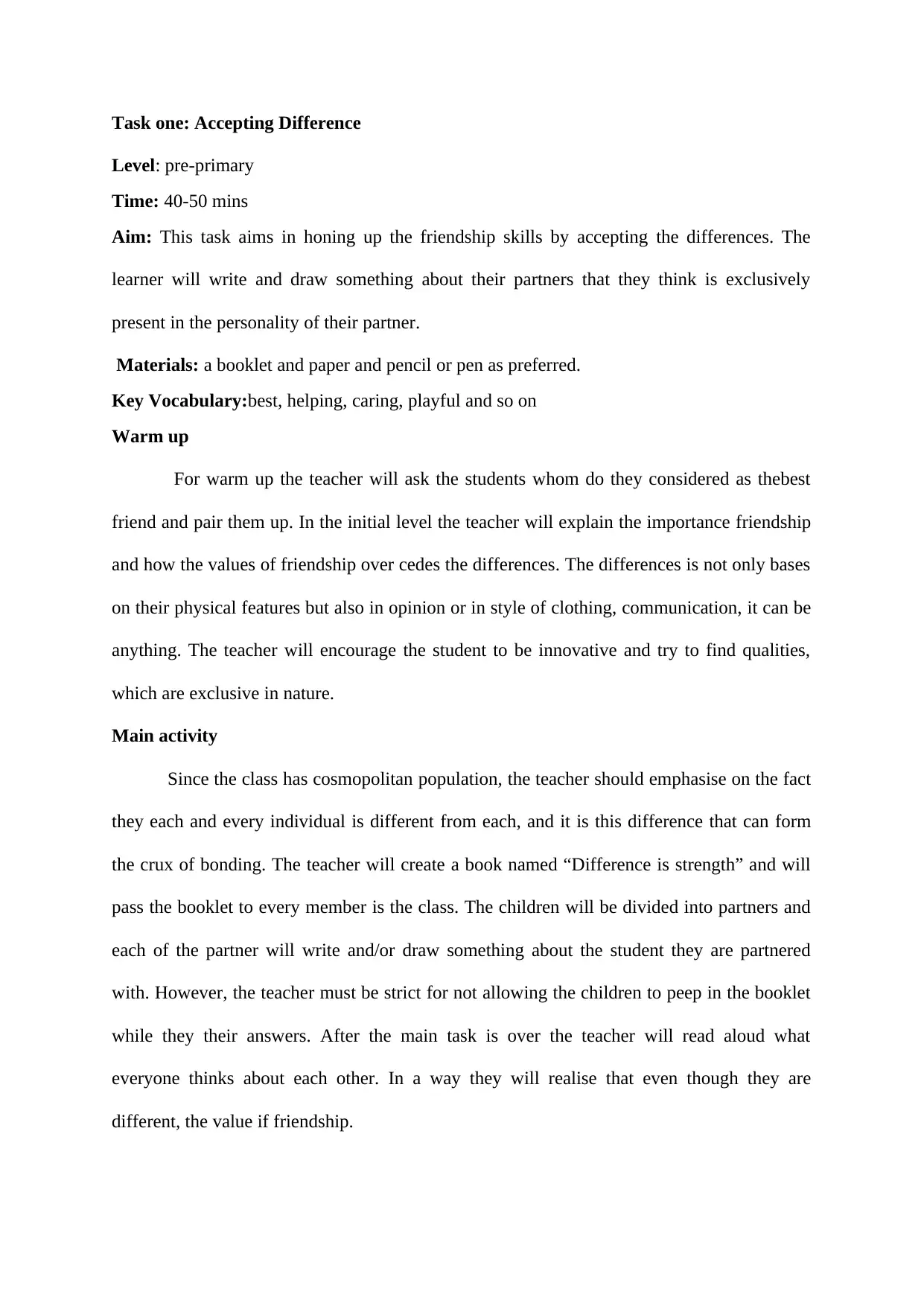
Task one: Accepting Difference
Level: pre-primary
Time: 40-50 mins
Aim: This task aims in honing up the friendship skills by accepting the differences. The
learner will write and draw something about their partners that they think is exclusively
present in the personality of their partner.
Materials: a booklet and paper and pencil or pen as preferred.
Key Vocabulary:best, helping, caring, playful and so on
Warm up
For warm up the teacher will ask the students whom do they considered as thebest
friend and pair them up. In the initial level the teacher will explain the importance friendship
and how the values of friendship over cedes the differences. The differences is not only bases
on their physical features but also in opinion or in style of clothing, communication, it can be
anything. The teacher will encourage the student to be innovative and try to find qualities,
which are exclusive in nature.
Main activity
Since the class has cosmopolitan population, the teacher should emphasise on the fact
they each and every individual is different from each, and it is this difference that can form
the crux of bonding. The teacher will create a book named “Difference is strength” and will
pass the booklet to every member is the class. The children will be divided into partners and
each of the partner will write and/or draw something about the student they are partnered
with. However, the teacher must be strict for not allowing the children to peep in the booklet
while they their answers. After the main task is over the teacher will read aloud what
everyone thinks about each other. In a way they will realise that even though they are
different, the value if friendship.
Level: pre-primary
Time: 40-50 mins
Aim: This task aims in honing up the friendship skills by accepting the differences. The
learner will write and draw something about their partners that they think is exclusively
present in the personality of their partner.
Materials: a booklet and paper and pencil or pen as preferred.
Key Vocabulary:best, helping, caring, playful and so on
Warm up
For warm up the teacher will ask the students whom do they considered as thebest
friend and pair them up. In the initial level the teacher will explain the importance friendship
and how the values of friendship over cedes the differences. The differences is not only bases
on their physical features but also in opinion or in style of clothing, communication, it can be
anything. The teacher will encourage the student to be innovative and try to find qualities,
which are exclusive in nature.
Main activity
Since the class has cosmopolitan population, the teacher should emphasise on the fact
they each and every individual is different from each, and it is this difference that can form
the crux of bonding. The teacher will create a book named “Difference is strength” and will
pass the booklet to every member is the class. The children will be divided into partners and
each of the partner will write and/or draw something about the student they are partnered
with. However, the teacher must be strict for not allowing the children to peep in the booklet
while they their answers. After the main task is over the teacher will read aloud what
everyone thinks about each other. In a way they will realise that even though they are
different, the value if friendship.
Paraphrase This Document
Need a fresh take? Get an instant paraphrase of this document with our AI Paraphraser
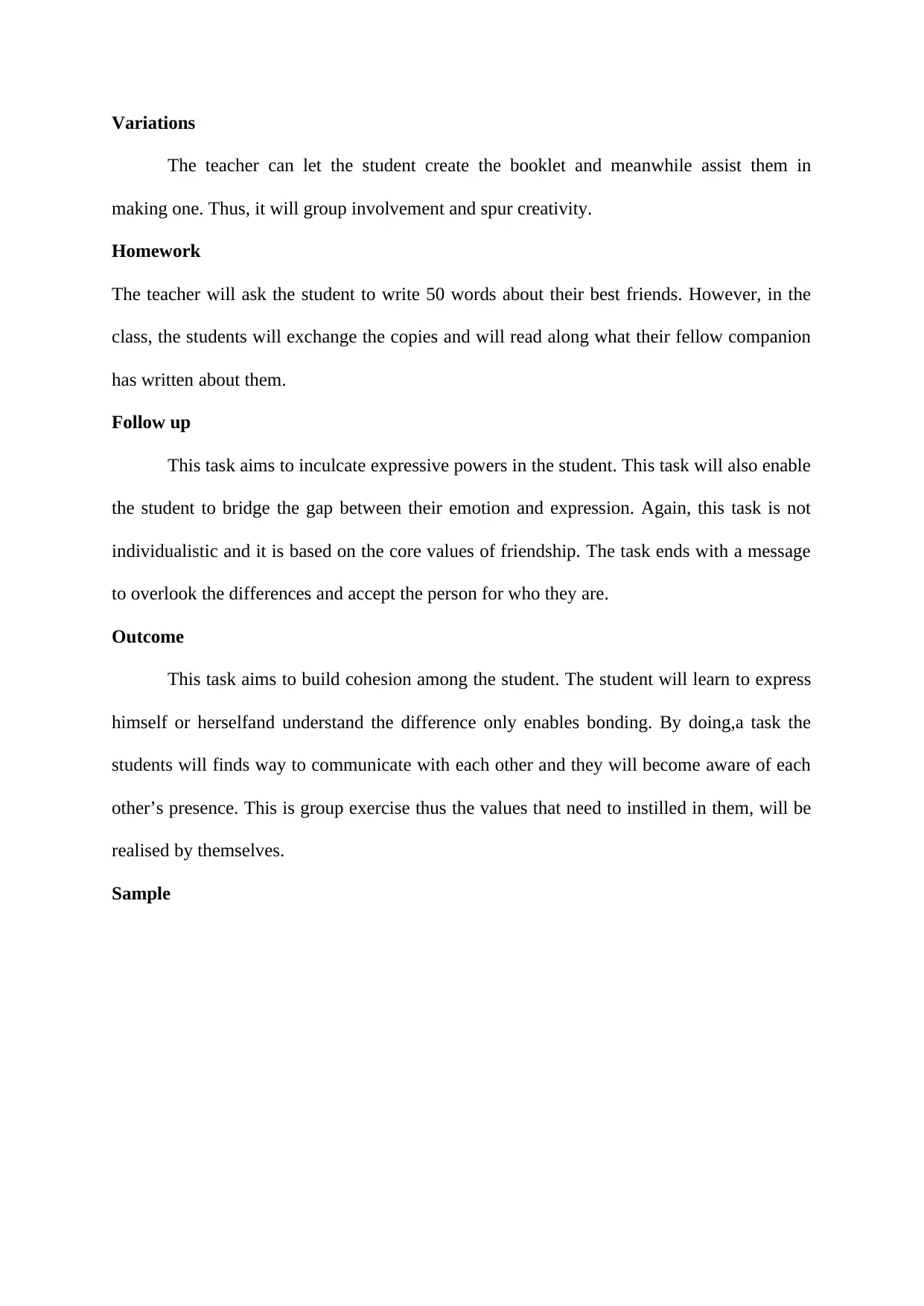
Variations
The teacher can let the student create the booklet and meanwhile assist them in
making one. Thus, it will group involvement and spur creativity.
Homework
The teacher will ask the student to write 50 words about their best friends. However, in the
class, the students will exchange the copies and will read along what their fellow companion
has written about them.
Follow up
This task aims to inculcate expressive powers in the student. This task will also enable
the student to bridge the gap between their emotion and expression. Again, this task is not
individualistic and it is based on the core values of friendship. The task ends with a message
to overlook the differences and accept the person for who they are.
Outcome
This task aims to build cohesion among the student. The student will learn to express
himself or herselfand understand the difference only enables bonding. By doing,a task the
students will finds way to communicate with each other and they will become aware of each
other’s presence. This is group exercise thus the values that need to instilled in them, will be
realised by themselves.
Sample
The teacher can let the student create the booklet and meanwhile assist them in
making one. Thus, it will group involvement and spur creativity.
Homework
The teacher will ask the student to write 50 words about their best friends. However, in the
class, the students will exchange the copies and will read along what their fellow companion
has written about them.
Follow up
This task aims to inculcate expressive powers in the student. This task will also enable
the student to bridge the gap between their emotion and expression. Again, this task is not
individualistic and it is based on the core values of friendship. The task ends with a message
to overlook the differences and accept the person for who they are.
Outcome
This task aims to build cohesion among the student. The student will learn to express
himself or herselfand understand the difference only enables bonding. By doing,a task the
students will finds way to communicate with each other and they will become aware of each
other’s presence. This is group exercise thus the values that need to instilled in them, will be
realised by themselves.
Sample
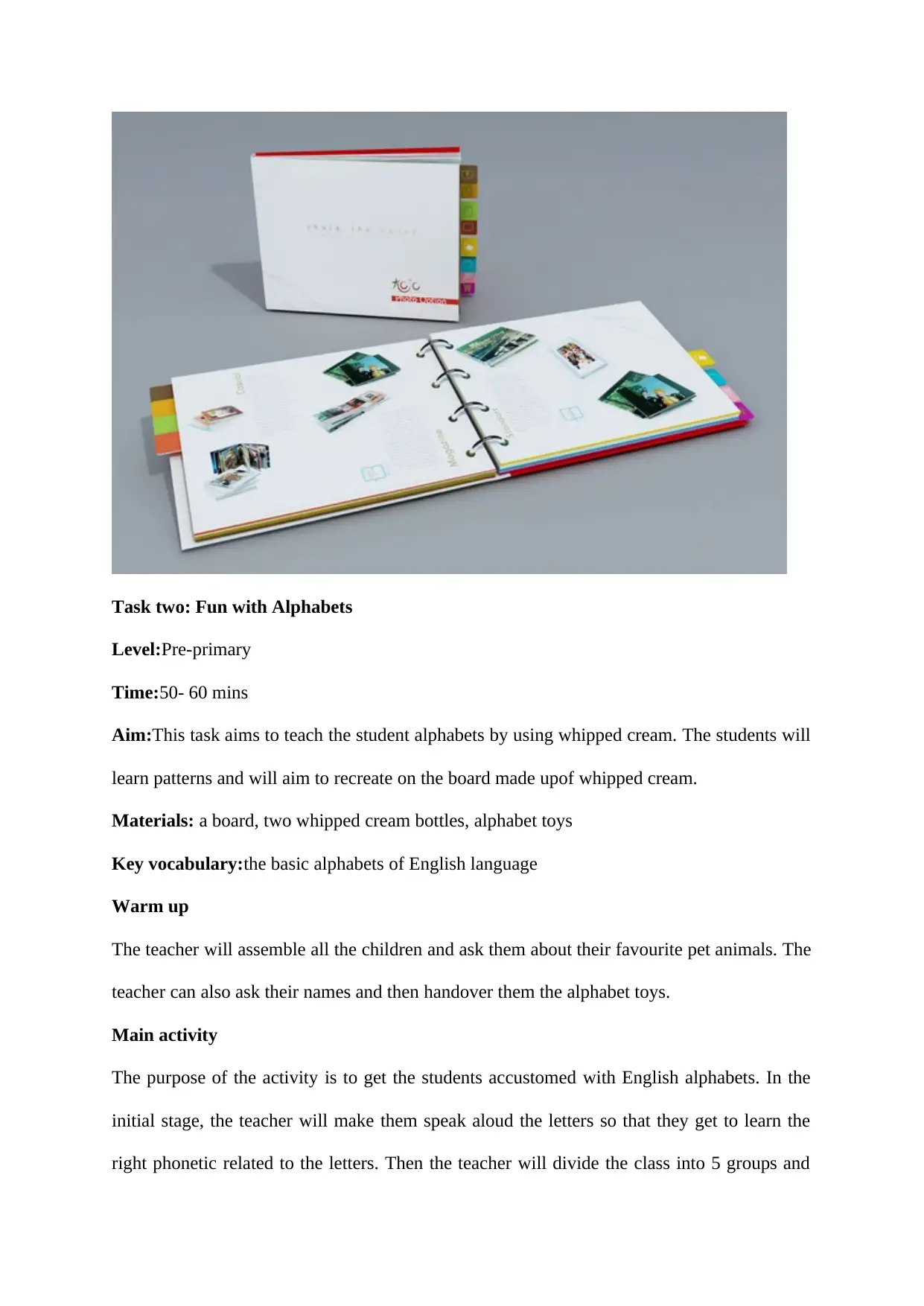
Task two: Fun with Alphabets
Level:Pre-primary
Time:50- 60 mins
Aim:This task aims to teach the student alphabets by using whipped cream. The students will
learn patterns and will aim to recreate on the board made upof whipped cream.
Materials: a board, two whipped cream bottles, alphabet toys
Key vocabulary:the basic alphabets of English language
Warm up
The teacher will assemble all the children and ask them about their favourite pet animals. The
teacher can also ask their names and then handover them the alphabet toys.
Main activity
The purpose of the activity is to get the students accustomed with English alphabets. In the
initial stage, the teacher will make them speak aloud the letters so that they get to learn the
right phonetic related to the letters. Then the teacher will divide the class into 5 groups and
Level:Pre-primary
Time:50- 60 mins
Aim:This task aims to teach the student alphabets by using whipped cream. The students will
learn patterns and will aim to recreate on the board made upof whipped cream.
Materials: a board, two whipped cream bottles, alphabet toys
Key vocabulary:the basic alphabets of English language
Warm up
The teacher will assemble all the children and ask them about their favourite pet animals. The
teacher can also ask their names and then handover them the alphabet toys.
Main activity
The purpose of the activity is to get the students accustomed with English alphabets. In the
initial stage, the teacher will make them speak aloud the letters so that they get to learn the
right phonetic related to the letters. Then the teacher will divide the class into 5 groups and
⊘ This is a preview!⊘
Do you want full access?
Subscribe today to unlock all pages.

Trusted by 1+ million students worldwide
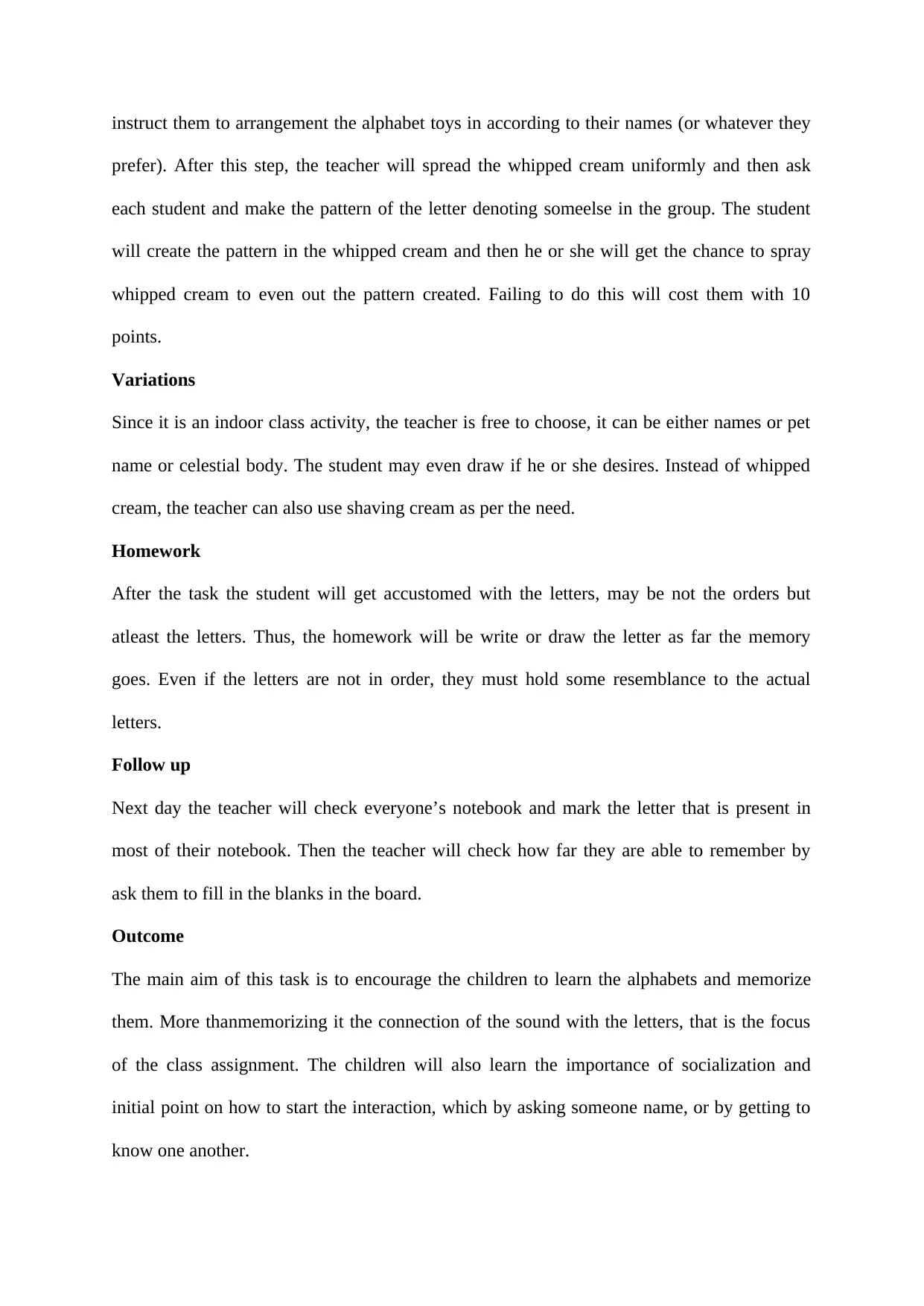
instruct them to arrangement the alphabet toys in according to their names (or whatever they
prefer). After this step, the teacher will spread the whipped cream uniformly and then ask
each student and make the pattern of the letter denoting someelse in the group. The student
will create the pattern in the whipped cream and then he or she will get the chance to spray
whipped cream to even out the pattern created. Failing to do this will cost them with 10
points.
Variations
Since it is an indoor class activity, the teacher is free to choose, it can be either names or pet
name or celestial body. The student may even draw if he or she desires. Instead of whipped
cream, the teacher can also use shaving cream as per the need.
Homework
After the task the student will get accustomed with the letters, may be not the orders but
atleast the letters. Thus, the homework will be write or draw the letter as far the memory
goes. Even if the letters are not in order, they must hold some resemblance to the actual
letters.
Follow up
Next day the teacher will check everyone’s notebook and mark the letter that is present in
most of their notebook. Then the teacher will check how far they are able to remember by
ask them to fill in the blanks in the board.
Outcome
The main aim of this task is to encourage the children to learn the alphabets and memorize
them. More thanmemorizing it the connection of the sound with the letters, that is the focus
of the class assignment. The children will also learn the importance of socialization and
initial point on how to start the interaction, which by asking someone name, or by getting to
know one another.
prefer). After this step, the teacher will spread the whipped cream uniformly and then ask
each student and make the pattern of the letter denoting someelse in the group. The student
will create the pattern in the whipped cream and then he or she will get the chance to spray
whipped cream to even out the pattern created. Failing to do this will cost them with 10
points.
Variations
Since it is an indoor class activity, the teacher is free to choose, it can be either names or pet
name or celestial body. The student may even draw if he or she desires. Instead of whipped
cream, the teacher can also use shaving cream as per the need.
Homework
After the task the student will get accustomed with the letters, may be not the orders but
atleast the letters. Thus, the homework will be write or draw the letter as far the memory
goes. Even if the letters are not in order, they must hold some resemblance to the actual
letters.
Follow up
Next day the teacher will check everyone’s notebook and mark the letter that is present in
most of their notebook. Then the teacher will check how far they are able to remember by
ask them to fill in the blanks in the board.
Outcome
The main aim of this task is to encourage the children to learn the alphabets and memorize
them. More thanmemorizing it the connection of the sound with the letters, that is the focus
of the class assignment. The children will also learn the importance of socialization and
initial point on how to start the interaction, which by asking someone name, or by getting to
know one another.
Paraphrase This Document
Need a fresh take? Get an instant paraphrase of this document with our AI Paraphraser
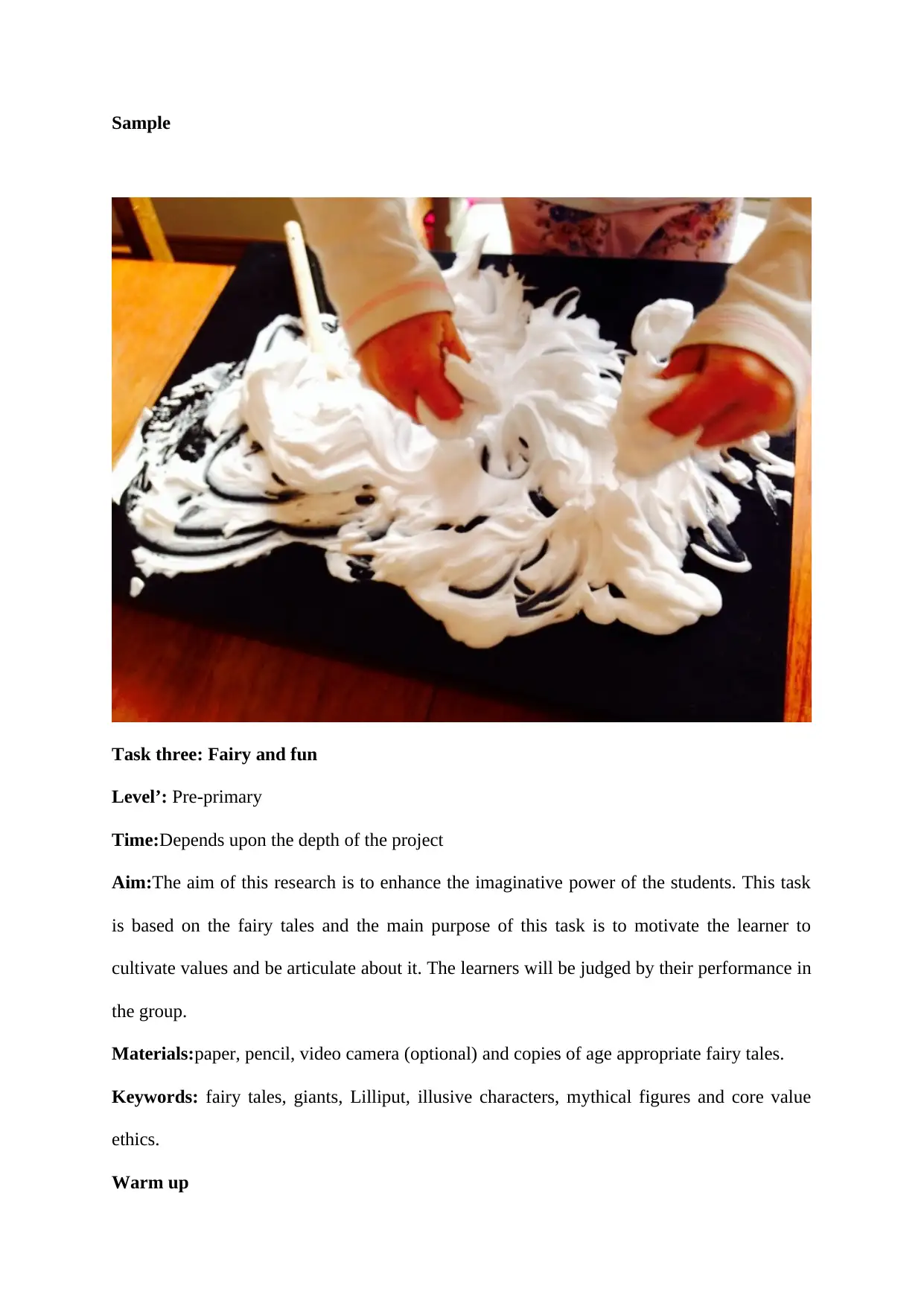
Sample
Task three: Fairy and fun
Level’: Pre-primary
Time:Depends upon the depth of the project
Aim:The aim of this research is to enhance the imaginative power of the students. This task
is based on the fairy tales and the main purpose of this task is to motivate the learner to
cultivate values and be articulate about it. The learners will be judged by their performance in
the group.
Materials:paper, pencil, video camera (optional) and copies of age appropriate fairy tales.
Keywords: fairy tales, giants, Lilliput, illusive characters, mythical figures and core value
ethics.
Warm up
Task three: Fairy and fun
Level’: Pre-primary
Time:Depends upon the depth of the project
Aim:The aim of this research is to enhance the imaginative power of the students. This task
is based on the fairy tales and the main purpose of this task is to motivate the learner to
cultivate values and be articulate about it. The learners will be judged by their performance in
the group.
Materials:paper, pencil, video camera (optional) and copies of age appropriate fairy tales.
Keywords: fairy tales, giants, Lilliput, illusive characters, mythical figures and core value
ethics.
Warm up

The teacher will narrate one of the fairy tales to the student and then will ask about the
opinion of the class. Then the teacher will take a session on how and why the journey of fairy
tales have been so successful. The ethical values or the moral principles are very important in
our lives and one should be very mindful regarding it. One should be aware about the moral
principles that are shaping their lives thus should compromise with it in any given situation.
Main activity
This task aims to get the learners accustomed with the power of articulation. It is based on the
performing arts and will require every children to participate in it. The teacher will divide the
class into feasible groups then the teacher will ask them to create their own fairy tales. Then
they need to script it based on the members present in the group. This means that they will
create a play based on their own life experience and then they will act it out. For giving a
boost to their creative zeal, they are allowed to make props needed to enhance the role of the
character.
Variations
It is the discretion of the teacher to choose which fairy tales to narrated in the class. The
teacher can also ask them to capitalize the letters they think should be capitalized. In this
way, they will understand the way in which emotions are conveyed in and through writing in
paper.
Follow up
The next day they need to present the drama for 20 mins each and student will be marked
based on their performance and the group coordination.
Homework
After this activity, the students will be asked to write a paragraph from what they
learned while doing the activity in the class. The student can talk about any particular things
opinion of the class. Then the teacher will take a session on how and why the journey of fairy
tales have been so successful. The ethical values or the moral principles are very important in
our lives and one should be very mindful regarding it. One should be aware about the moral
principles that are shaping their lives thus should compromise with it in any given situation.
Main activity
This task aims to get the learners accustomed with the power of articulation. It is based on the
performing arts and will require every children to participate in it. The teacher will divide the
class into feasible groups then the teacher will ask them to create their own fairy tales. Then
they need to script it based on the members present in the group. This means that they will
create a play based on their own life experience and then they will act it out. For giving a
boost to their creative zeal, they are allowed to make props needed to enhance the role of the
character.
Variations
It is the discretion of the teacher to choose which fairy tales to narrated in the class. The
teacher can also ask them to capitalize the letters they think should be capitalized. In this
way, they will understand the way in which emotions are conveyed in and through writing in
paper.
Follow up
The next day they need to present the drama for 20 mins each and student will be marked
based on their performance and the group coordination.
Homework
After this activity, the students will be asked to write a paragraph from what they
learned while doing the activity in the class. The student can talk about any particular things
⊘ This is a preview!⊘
Do you want full access?
Subscribe today to unlock all pages.

Trusted by 1+ million students worldwide
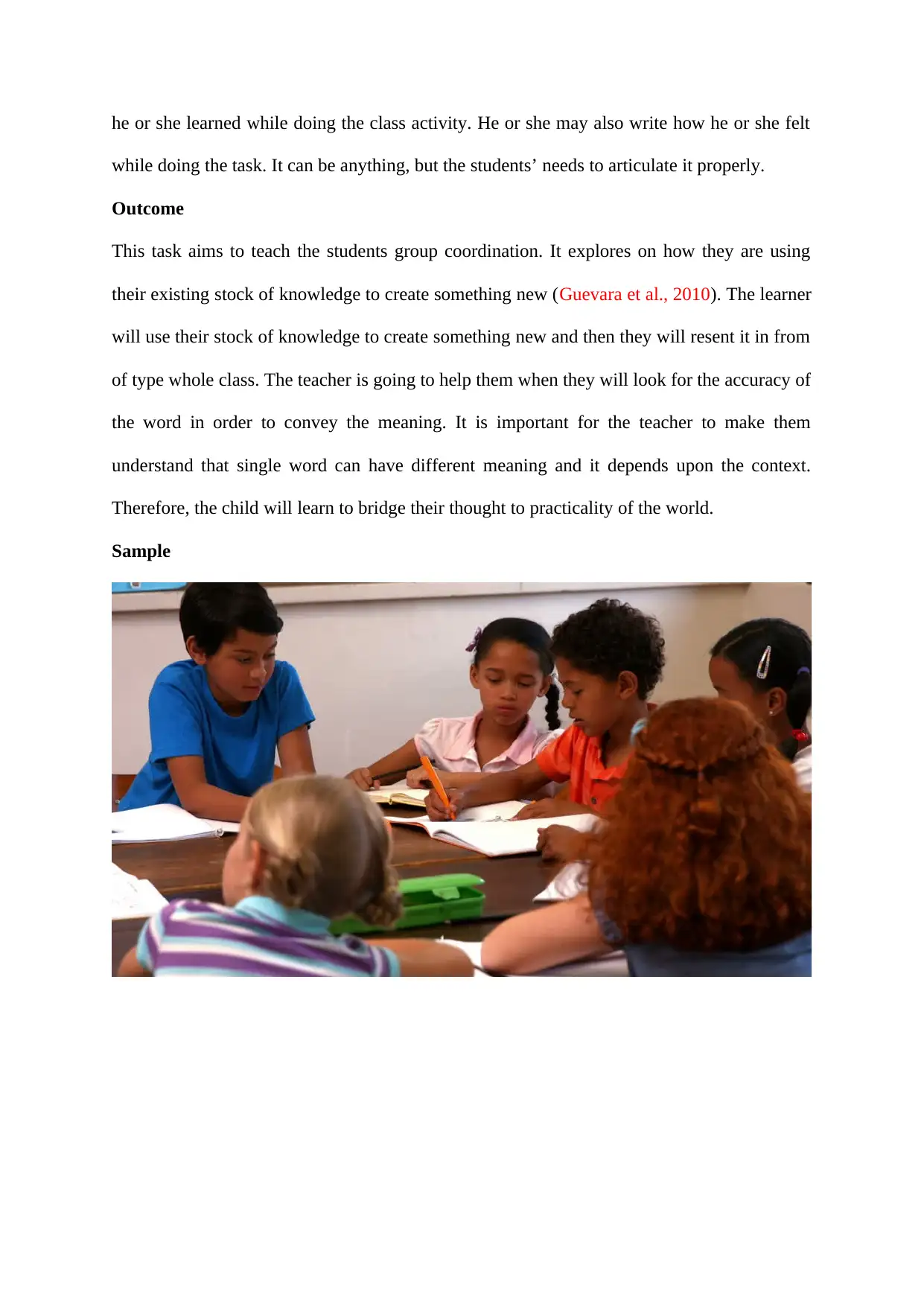
he or she learned while doing the class activity. He or she may also write how he or she felt
while doing the task. It can be anything, but the students’ needs to articulate it properly.
Outcome
This task aims to teach the students group coordination. It explores on how they are using
their existing stock of knowledge to create something new (Guevara et al., 2010). The learner
will use their stock of knowledge to create something new and then they will resent it in from
of type whole class. The teacher is going to help them when they will look for the accuracy of
the word in order to convey the meaning. It is important for the teacher to make them
understand that single word can have different meaning and it depends upon the context.
Therefore, the child will learn to bridge their thought to practicality of the world.
Sample
while doing the task. It can be anything, but the students’ needs to articulate it properly.
Outcome
This task aims to teach the students group coordination. It explores on how they are using
their existing stock of knowledge to create something new (Guevara et al., 2010). The learner
will use their stock of knowledge to create something new and then they will resent it in from
of type whole class. The teacher is going to help them when they will look for the accuracy of
the word in order to convey the meaning. It is important for the teacher to make them
understand that single word can have different meaning and it depends upon the context.
Therefore, the child will learn to bridge their thought to practicality of the world.
Sample
Paraphrase This Document
Need a fresh take? Get an instant paraphrase of this document with our AI Paraphraser
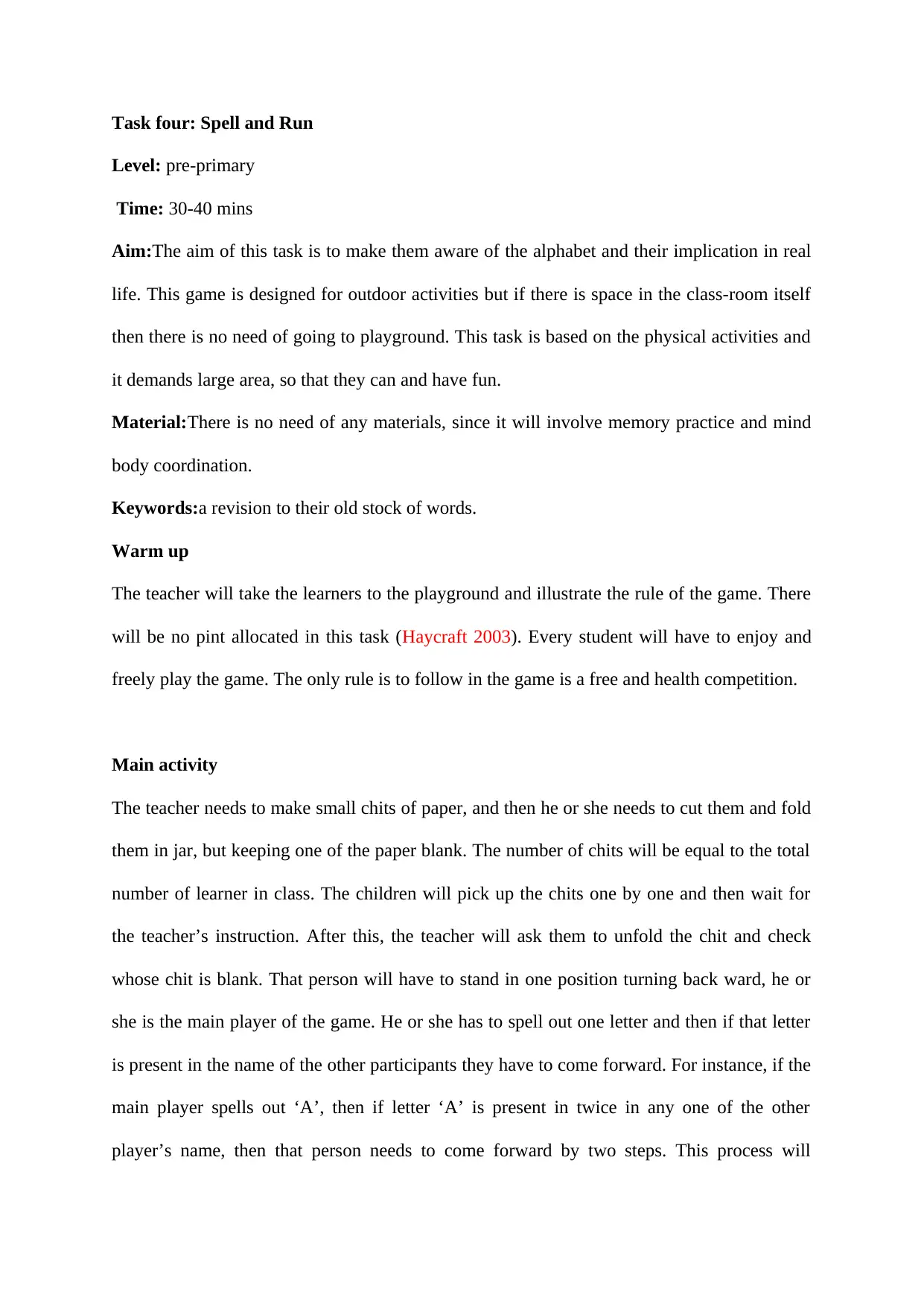
Task four: Spell and Run
Level: pre-primary
Time: 30-40 mins
Aim:The aim of this task is to make them aware of the alphabet and their implication in real
life. This game is designed for outdoor activities but if there is space in the class-room itself
then there is no need of going to playground. This task is based on the physical activities and
it demands large area, so that they can and have fun.
Material:There is no need of any materials, since it will involve memory practice and mind
body coordination.
Keywords:a revision to their old stock of words.
Warm up
The teacher will take the learners to the playground and illustrate the rule of the game. There
will be no pint allocated in this task (Haycraft 2003). Every student will have to enjoy and
freely play the game. The only rule is to follow in the game is a free and health competition.
Main activity
The teacher needs to make small chits of paper, and then he or she needs to cut them and fold
them in jar, but keeping one of the paper blank. The number of chits will be equal to the total
number of learner in class. The children will pick up the chits one by one and then wait for
the teacher’s instruction. After this, the teacher will ask them to unfold the chit and check
whose chit is blank. That person will have to stand in one position turning back ward, he or
she is the main player of the game. He or she has to spell out one letter and then if that letter
is present in the name of the other participants they have to come forward. For instance, if the
main player spells out ‘A’, then if letter ‘A’ is present in twice in any one of the other
player’s name, then that person needs to come forward by two steps. This process will
Level: pre-primary
Time: 30-40 mins
Aim:The aim of this task is to make them aware of the alphabet and their implication in real
life. This game is designed for outdoor activities but if there is space in the class-room itself
then there is no need of going to playground. This task is based on the physical activities and
it demands large area, so that they can and have fun.
Material:There is no need of any materials, since it will involve memory practice and mind
body coordination.
Keywords:a revision to their old stock of words.
Warm up
The teacher will take the learners to the playground and illustrate the rule of the game. There
will be no pint allocated in this task (Haycraft 2003). Every student will have to enjoy and
freely play the game. The only rule is to follow in the game is a free and health competition.
Main activity
The teacher needs to make small chits of paper, and then he or she needs to cut them and fold
them in jar, but keeping one of the paper blank. The number of chits will be equal to the total
number of learner in class. The children will pick up the chits one by one and then wait for
the teacher’s instruction. After this, the teacher will ask them to unfold the chit and check
whose chit is blank. That person will have to stand in one position turning back ward, he or
she is the main player of the game. He or she has to spell out one letter and then if that letter
is present in the name of the other participants they have to come forward. For instance, if the
main player spells out ‘A’, then if letter ‘A’ is present in twice in any one of the other
player’s name, then that person needs to come forward by two steps. This process will
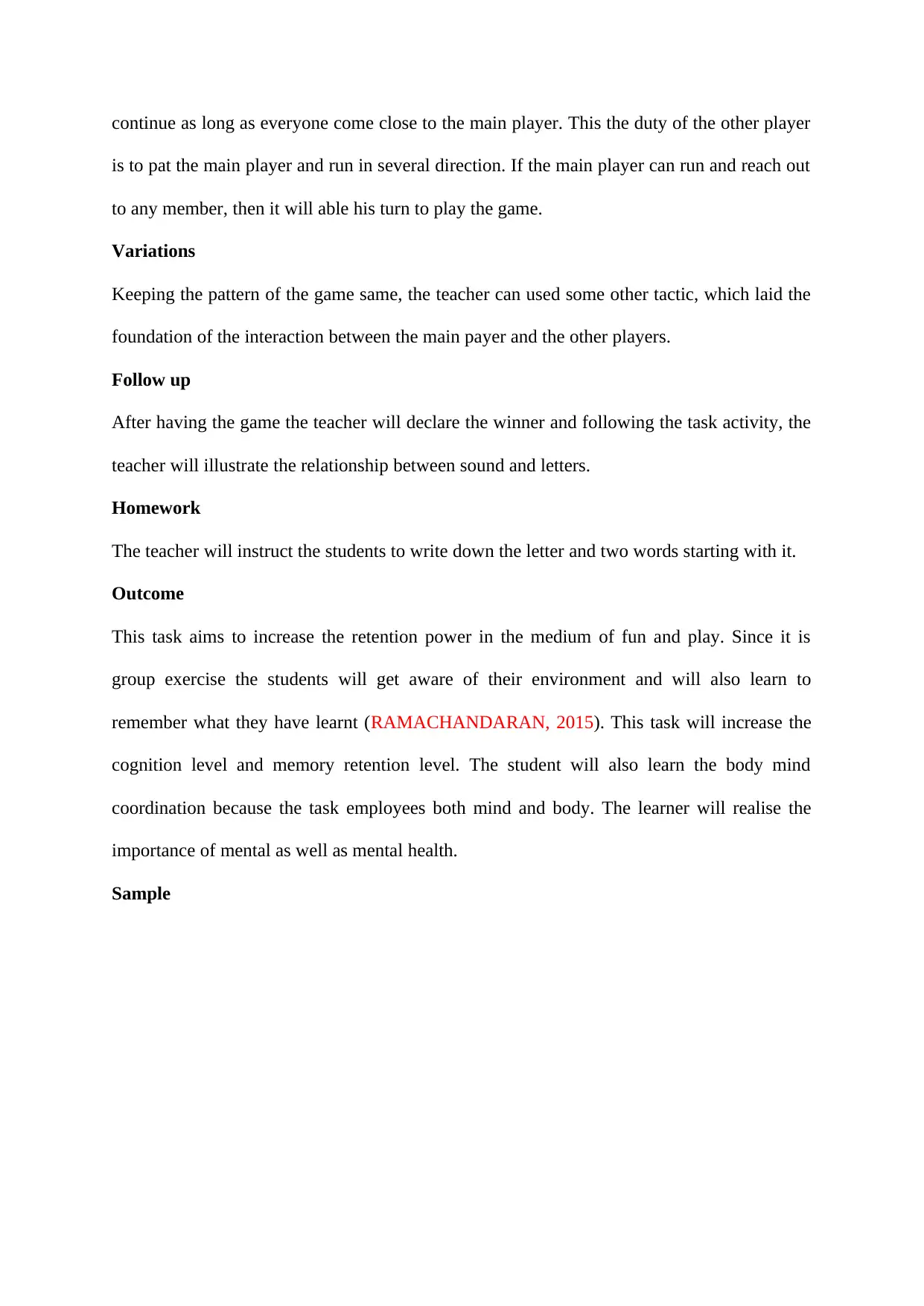
continue as long as everyone come close to the main player. This the duty of the other player
is to pat the main player and run in several direction. If the main player can run and reach out
to any member, then it will able his turn to play the game.
Variations
Keeping the pattern of the game same, the teacher can used some other tactic, which laid the
foundation of the interaction between the main payer and the other players.
Follow up
After having the game the teacher will declare the winner and following the task activity, the
teacher will illustrate the relationship between sound and letters.
Homework
The teacher will instruct the students to write down the letter and two words starting with it.
Outcome
This task aims to increase the retention power in the medium of fun and play. Since it is
group exercise the students will get aware of their environment and will also learn to
remember what they have learnt (RAMACHANDARAN, 2015). This task will increase the
cognition level and memory retention level. The student will also learn the body mind
coordination because the task employees both mind and body. The learner will realise the
importance of mental as well as mental health.
Sample
is to pat the main player and run in several direction. If the main player can run and reach out
to any member, then it will able his turn to play the game.
Variations
Keeping the pattern of the game same, the teacher can used some other tactic, which laid the
foundation of the interaction between the main payer and the other players.
Follow up
After having the game the teacher will declare the winner and following the task activity, the
teacher will illustrate the relationship between sound and letters.
Homework
The teacher will instruct the students to write down the letter and two words starting with it.
Outcome
This task aims to increase the retention power in the medium of fun and play. Since it is
group exercise the students will get aware of their environment and will also learn to
remember what they have learnt (RAMACHANDARAN, 2015). This task will increase the
cognition level and memory retention level. The student will also learn the body mind
coordination because the task employees both mind and body. The learner will realise the
importance of mental as well as mental health.
Sample
⊘ This is a preview!⊘
Do you want full access?
Subscribe today to unlock all pages.

Trusted by 1+ million students worldwide
1 out of 20
Related Documents
Your All-in-One AI-Powered Toolkit for Academic Success.
+13062052269
info@desklib.com
Available 24*7 on WhatsApp / Email
![[object Object]](/_next/static/media/star-bottom.7253800d.svg)
Unlock your academic potential
Copyright © 2020–2025 A2Z Services. All Rights Reserved. Developed and managed by ZUCOL.





